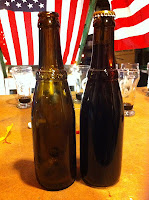 Florida. We’d tell you more, but you’ve already heard about the others. Plus, it’s called vacation for a reason.
Florida. We’d tell you more, but you’ve already heard about the others. Plus, it’s called vacation for a reason.
Described on the label as “hoppier than a bullfrog with a stubbed toe,” Hoplanta pours a clear copper with a fair amount of orange and a profuse off-white head that hangs around while offering a fair amount of lacing. The nose is bread, caramel, and a touch of butter on the malt-side, with small amounts of bitterness and a touch of pine on the hop-side. Flavors start with creamy caramel and toast that segues into hop bitterness in the middle; there is more bread crust heading into the finish and some lingering, clean bitterness along with a slight grassiness. The citrus described on the website appears to be incognito, although there might be hints of the pine remaining in the aftertaste—not so much in the body, though. The body is medium and chewy, with a creamy,  well-rounded carbonation that sits well on the tongue. A decent beer—we could make an evening of it if this was the best offered, but there is a lot better out there. It could be that this six-pack is a bit past its prime, but even with a punchier hop presence in the flavor and aroma, this beer still tastes like a career AAA player. Love the label, and we do wish it was better, but the beer is only average. Still, out rowing around on a rowboat, it does hit the spot.
well-rounded carbonation that sits well on the tongue. A decent beer—we could make an evening of it if this was the best offered, but there is a lot better out there. It could be that this six-pack is a bit past its prime, but even with a punchier hop presence in the flavor and aroma, this beer still tastes like a career AAA player. Love the label, and we do wish it was better, but the beer is only average. Still, out rowing around on a rowboat, it does hit the spot.
 well-rounded carbonation that sits well on the tongue. A decent beer—we could make an evening of it if this was the best offered, but there is a lot better out there. It could be that this six-pack is a bit past its prime, but even with a punchier hop presence in the flavor and aroma, this beer still tastes like a career AAA player. Love the label, and we do wish it was better, but the beer is only average. Still, out rowing around on a rowboat, it does hit the spot.
well-rounded carbonation that sits well on the tongue. A decent beer—we could make an evening of it if this was the best offered, but there is a lot better out there. It could be that this six-pack is a bit past its prime, but even with a punchier hop presence in the flavor and aroma, this beer still tastes like a career AAA player. Love the label, and we do wish it was better, but the beer is only average. Still, out rowing around on a rowboat, it does hit the spot. ABV: 6.7%
IBU: 50
Malts: 2-row, Vienna, and Caramel
Hops: Bravo and Cascade
(12/28/2012)
















































